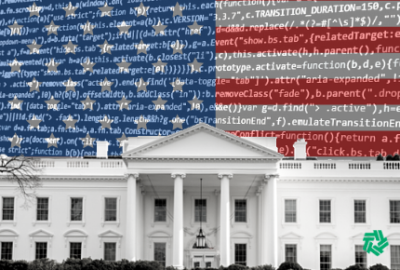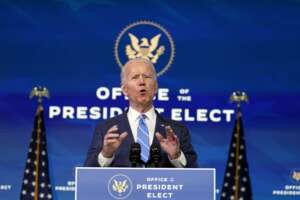

President-elect Biden announces American Rescue Plan that includes significant funding increases for federal technology and cybersecurity to address long-standi...
President-elect Joe Biden wants to give federal technology modernization and cybersecurity efforts a historic increase.
As part of his COVID relief proposal to Congress, Biden called the need to upgrade the federal IT infrastructure an urgent national security issue. To that end, the proposal requests $9 billion for the Technology Modernization Fund—a 3,600% increase over the $25 million it received in fiscal 2020.

“In addition, the President-elect is calling on Congress to change the fund’s reimbursement structure in order to fund more innovative and impactful projects,” the transition fact sheet released Jan. 14 states ahead of the President-elect’s speech.
Former federal officials and other experts say the requirement to pay back the TMF fund has hindered the program over the last few years as well as the Senate’s hesitation to fully fund the administration’s request. It’s unclear if this is what the incoming Biden administration is talking about changing, but it’s a common topic of discussion in the federal community.
“By asking for $9 billion in TMF funding, the Biden team clearly understands its unique value proposition and ability to drive critical IT modernization efforts that can support agency efforts to respond to COVID-19 and accelerate the delivery of enhanced digital services that citizens are demanding,” said Matt Cornelius, the executive director of the Alliance for Digital Innovation, an industry association, and a former senior technology and cybersecurity advisor at the Office of Management and Budget. “OMB and GSA could use this infusion of capital to ‘flip the model’ of the TMF and use it to fund large-scale, enterprisewide IT modernization efforts across some or all federal agencies, while still making targeted investments in individual agency programs that could benefit from the TMF Board’s oversight and the flexibility of funding that TMF provides.”
Cornelius added the strict reimbursement strings hampers the number and quality of proposals.
“By eliminating or significantly altering those restrictions, the Biden plan would ensure the TMF is not only well capitalized, but able to quickly and effectively deploy IT modernization dollars to deal with high priority agency technology initiatives, especially those that can accelerate the recovery from COVID-19,” he said.
The Biden proposal follows similar attempts by House and Senate Democrats to add more money to the TMF in previous pandemic relief bills. In July, Rep. Steny Hoyer (D-Md.) wanted to appropriate $3 billion for TMF as a line item for the IRS. Rep. Gerry Connolly (D-Va.) also tried to increase the TMF by $3 billion in May. These and other attempts never made it past the Senate.
Jason Oxman, president and CEO of the IT Industry Council, said in a statement that the proposal seeks to address long overdue federal IT and cybersecurity needs.
“These investments in technology infrastructure, tools, and workforce are essential to ensure recovery from the SolarWinds breach, and to deliver modern and secure citizen services and critical networks,” Oxman said.
Along with the TMF, the President-elect proposed another $300 million for IT modernization initiatives led by the General Services Administration’s Technology Transformation Service. This would be no-year funding to “drive secure IT projects forward without the need of reimbursement from agencies.”
TTS, which houses the 18F organization and the IT Modernization Centers of Excellence, is partly funded through the Federal Citizen Service Fund and partly by agency fees for services. The FCSF received $55 million in 2021, which is $3 million less than the administration requested. But by having no-year funding, 18F and the CoEs could assist more agencies on modernization efforts and not have to worry about getting all the funding out the door in one year.
TTS expects to bring in about $118 million in revenue and make a “profit” of about $58 million in 2021, according to GSA’s budget justification from February 2020. It also plans to increase the number of employees to 223 from 218 in 2020.
Cybersecurity is often the reason why agencies need to modernize IT. The Biden proposal continues to follow that story line.
Biden’s plan calls for the Cybersecurity and Infrastructure Security Agency (CISA) at the Homeland Security Department to receive an additional $690 million to “bolster cybersecurity across federal civilian networks, and support the piloting of new shared security and cloud computing services.”
Lawmakers already appropriated in 2021 $2 billion for CISA, including $1.2 billion for cybersecurity and the protection of civilian federal networks. The spending bill also included $716 million for the National Cybersecurity Protection System and an extra $40 million for the Continuous Diagnostics and Mitigation (CDM) program for a total of $214 million.
“In addition to the COVID-19 crisis, we also face a crisis when it comes to the nation’s cybersecurity,” the transition fact sheet stated. “The recent cybersecurity breaches of federal government data systems underscore the importance and urgency of strengthening U.S. cybersecurity capabilities. President-elect Biden is calling on Congress to launch the most ambitious effort ever to modernize and secure federal IT and networks.”
All of this money needs people to support the contracting and implementation of the technology. So the Biden team is requesting $200 million to hire cybersecurity and engineering experts. The proposal called for the money to go to the Information Technology Oversight and Reform (ITOR) fund to help rapidly hire hundreds of experts to support the federal chief information security officer and U.S. Digital Service.
“The investments the Biden plan would like to see in IT Oversight and Reform (ITOR) fund and at GSA’s TTS clearly indicate that they would like to hire additional tech talent to deal with the significant digital services, cybersecurity, data, and technology challenges across government,” Cornelius said. “It is critically important that Biden hires highly skilled technology talent at OMB and GSA, but he also needs to ensure that some of those dollars can be used to support filling the substantial tech talent gap at all federal agencies, where the workforce is closer to mission and more knowledgeable of the technology and security needs of their department.”
Copyright © 2024 Federal News Network. All rights reserved. This website is not intended for users located within the European Economic Area.
Jason Miller is executive editor of Federal News Network and directs news coverage on the people, policy and programs of the federal government.
Follow @jmillerWFED


